This article needs additional citations for verification .(October 2011) |
The earliest known chess column appeared in the Lancet in 1823, but due to lack of popularity disappeared after less than a year.
This article needs additional citations for verification .(October 2011) |
The earliest known chess column appeared in the Lancet in 1823, but due to lack of popularity disappeared after less than a year.
The first column to establish itself was that of George Walker in Bells Life in 1834 which survived until 1873. From February 15, 1845, onwards it faced competition from Howard Staunton's column in the Illustrated London News , a column which outlived Walker's, but only by 5 years. During this time a chess column also appeared in the Pictorial Times lasting from February 1845 to June 1848.
In 1882 Henry Bird in his Chess History and Reminiscences estimated that there were 150 chess columns. Less than thirty years later in 1913 H. J. R. Murray in his A History of Chess estimated there existed at least 1,000 chess columns worldwide.
George Koltanowski became the chess columnist for the San Francisco Chronicle , which carried his chess column every day for the next 52 years until his death, publishing an estimated 19,000 columns. American Grandmaster Robert Byrne wrote a column for The New York Times from 1972 to 2006. [1] GM Lubomir Kavalek's column in The Washington Post ran from 1986 to 2010. [2] GM Nigel Short wrote a chess column for the Sunday Telegraph from 1995 to 2005, and then for The Guardian from 2005 to 2006. [3] GM Jon Speelman wrote for The Guardian from 2005 to 2008. GM Patrick Wolff was co-writing a column for the Boston Globe in 2012. [4]
Raymond Keene's column appears daily in The Times and Sunday Times . Bill Cornwall's "Chess: A Knight's Tour" has been published by Tribune since 1993, and appears in the Sun-Sentinel and Los Angeles Times. [5]
A record of longevity has been achieved by Leonard Barden, who still writes weekly chess columns for The Guardian and has done since September 1955 (61 years as of August 2017), and daily columns for the London Evening Standard since June 1956 (61 years as of August 2017). [6]
As of June 2022 the writer for the New York Times chess column is Daniel Naroditsky. [7]

Judit Polgár is a Hungarian chess grandmaster, widely regarded as the strongest female chess player of all time. In 1991, Polgár achieved the title of Grandmaster at the age of 15 years and 4 months, at the time the youngest to have done so, breaking the record previously held by former world champion Bobby Fischer. She was the youngest player ever to break into the FIDE top 100 players rating list, ranking No. 55 in the January 1989 rating list, at the age of 12.

Nigel David Short is an English chess grandmaster, columnist, coach and commentator who has been the FIDE Director for Chess Development since September 2022. Short earned the title of grandmaster at the age of 19 and was ranked third in the world by FIDE from July 1988 to July 1989. In 1993, he became the first English player to play a World Chess Championship match, when he qualified to play Garry Kasparov in the PCA world championship in London, where Kasparov won 12½ to 7½.

Luke James McShane is an English chess player. A chess prodigy, he was awarded the title of Grandmaster by FIDE in 2000, at the age of 16. McShane has become one of England's leading players and a member of the national team. He also worked as a trader in London's financial sector, and has previously been described as the world's strongest amateur chess player.

A chess prodigy is a young child who possesses an aptitude for the game of chess that far exceeds what might be expected at their age. Their prodigious talent will often enable them to defeat experienced adult players and even titled chess masters. Some chess prodigies have progressed to become grandmasters or even World Chess Champions.

Jonathan Penrose, was an English chess player, who held the titles Grandmaster (1993) and International Correspondence Chess Grandmaster (1983). He won the British Chess Championship ten times between 1958 and 1969.
Leonard William Barden is an English chess master, writer, broadcaster, journalist, organizer and promoter. The son of a dustman, he was educated at Whitgift School, South Croydon, and Balliol College, Oxford, where he read modern history. Barden learned to play chess at age 13 while in a school shelter during a World War II German air raid. Within a few years he became one of the country's leading juniors. Barden represented England in four Chess Olympiads. He played a major role in the rise of English chess from the 1970s. Barden is a chess columnist for various newspapers. His column in London's Evening Standard is the world's longest-running daily chess column by the same author.

British Chess Magazine is the world's oldest chess journal in continuous publication. First published in January 1881, it has appeared at monthly intervals ever since. It is frequently known in the chess world as BCM.
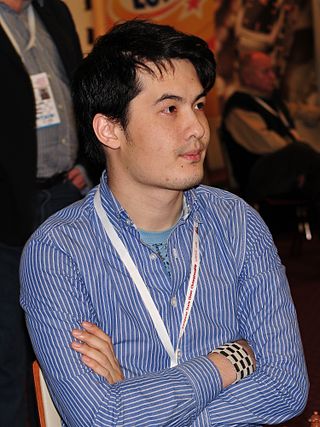
David Wei Liang Howell is an English chess grandmaster and commentator. A three-time British champion, he holds the record for being the second youngest British person to achieve the title of Grandmaster, earned at the age of 16.

Nicholas G. Pert is an English chess grandmaster.
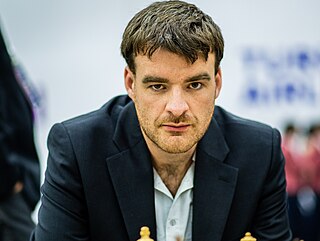
Gawain Christopher Bernard Jones is an English chess grandmaster and three-time British Chess Champion. He was awarded the grandmaster title by FIDE in 2007. He competed in the FIDE World Cup in 2013, 2017 and 2019.

Daniel Naroditsky often referred to as Danya, is an American chess grandmaster, author, and commentator.
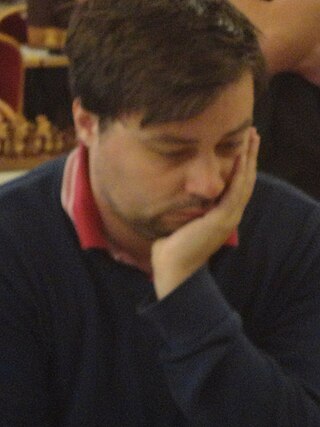
Jonathan Hawkins is an English chess grandmaster. He was the British Chess Champion in 2015, having outscored David Howell, with whom he shared the title in 2014.

Rameshbabu Praggnanandhaa is an Indian chess grandmaster. As of 2 September 2024, Praggnanandhaa is ranked 12th in the world by the International Chess Federation. Praggnanandhaa and his sister Vaishali are the first brother and sister to earn GM titles. They are also the first brother and sister to qualify for the Candidates Tournament.

Vincent Keymer is a German chess grandmaster. He was the No.1 in the FIDE World Chess Ratings for Juniors in January 2024.

Gukesh Dommaraju, also known as Gukesh D, is an Indian chess grandmaster. He is the third-youngest grandmaster in history, the third-youngest to reach a chess rating of 2700, the youngest to reach a rating of 2750, and is the eighteenth-highest rated player in history with a peak rating of 2794. He is also the youngest Candidates Tournament winner and the youngest contender to compete for the World Championship. He has won one team and two individual gold medals at the Olympiad as well as one bronze team medal. He is a silver medalist at the Asian Games.
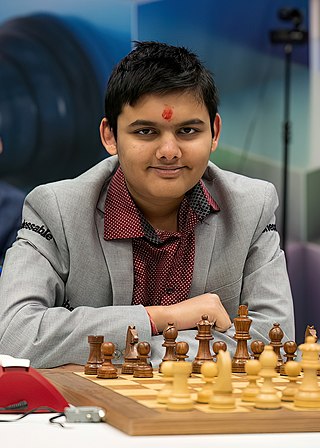
Abhimanyu Mishra is an American chess grandmaster and chess prodigy. He is the youngest player to attain the grandmaster title, having obtained it at the age of 12 years, 4 months, and 25 days. Along with the feat of becoming the youngest GM in history, Mishra also holds or has held additional "youngest" chess performance titles and records.

Women represent a small minority of chess players at all ages and levels. Female chess players today generally compete in a mix of open tournaments and women's tournaments, the latter of which are most prominent at or near the top level of women's chess and at youth levels. Modern top-level women's tournaments help provide a means for some participants to be full-time professional chess players. The majority of these tournaments are organized by the International Chess Federation (FIDE) and revolve around the World Championship cycle, which culminates in a match to decide the Women's World Chess Champion. Beyond those events, among the most prominent women's tournaments are women's and girls' national and continental championships.
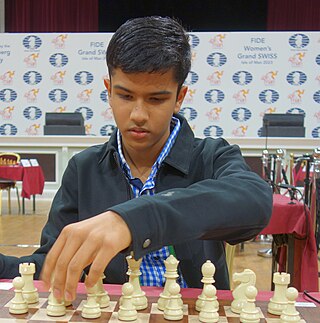
Shreyas Royal is an English chess grandmaster. A chess prodigy, he became a grandmaster at the age of 15 years and 7 months, making him the youngest English player to achieve the title.